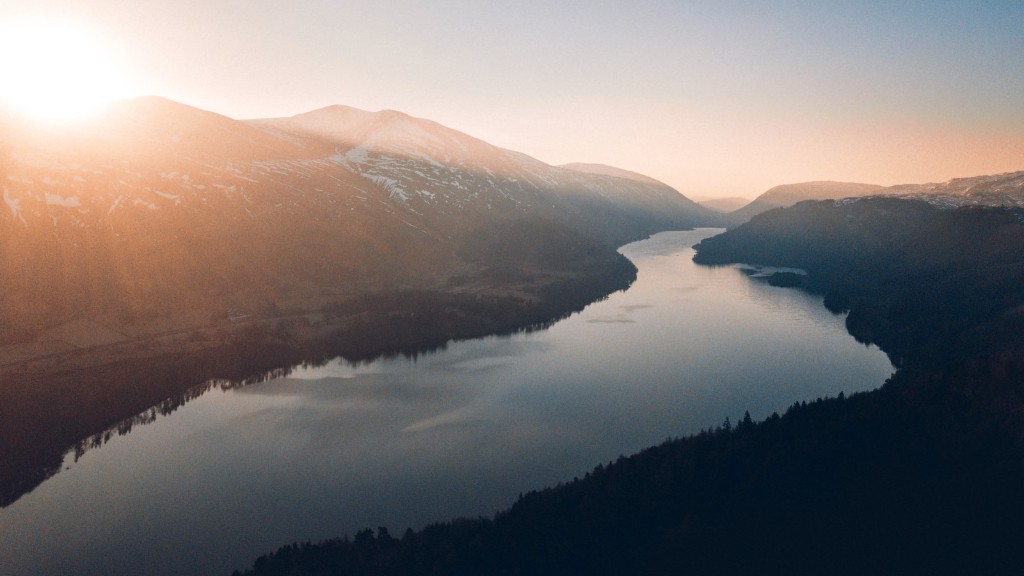Impact of Mississippi River in the US
The Mississippi River has always been an important part of the United States and is one of the most iconic and studied rivers in the world. It is the largest river in terms of drainage area, supplying over 30 percent of the nation’s water. The Mississippi is often referred to as a “highway” in the United States, but what impact has it had on our country?
First of all, the river has played an integral part in the development of the US economy. Big cities and towns have historically been built along the Mississippi, as seen in Memphis and Vicksburg, as well as the very port in New Orleans. In these cities, the proximity to the river allowed for easier trading, shipping and transportation of goods, allowing them to thrive as business cities.
Manufacturing, the main sector of the US economy, is still heavily dependent on the Mississippi. In fact, the construction of the locks and dams that hold and move the river water made possible the export and import of several commodities. The massive barge fleets that transport agricultural products, crude oil, and chemicals of all kinds, among many other products, along the river serve as evidence of the economic significance of the Mississippi.
One of the most significant contributions of the Mississippi to the US economy is tourism. The Mississippi River Delta has a vast variety of different habitats, and around the river, visitors can find wetlands, swamps, and woodlands. This creates a unique ecosystem that attracts wildlife, and naturally, tourists. Tourism generates an estimated $3 billion in economic activity annually in the Delta.
The Mississippi River is one of the most important waterways in the US, as it provides access to the interior of the continent. This has allowed for the country’s growth both economically and culturally, for not only Americans but for immigrants as well. The river served as an access to new farmlands, jobs, and the dream of a better future for many displaced people. It has also been a pathway for African American culture, music, and art, which has become a crucial part of the American culture.
The river is also one of the most important sources of clean drinking water in the country. The fact that the pollutants generated not only by industry but also by agricultural activities have not affected the Mississippi River as much as other rivers around the US points out to the success of the various programs that have been implemented over the last years to protect the river.
The Mississippi River is a symbol of both culture and economic power in the US, as it provides a variety of services that are surprising for a simple river. The importance of the Mississippi should be acknowledged, as it has shaped the United States as we know it.
Geology of the Mississippi River
The geological features of the Mississippi River are essential in understanding why it is more of a highway than other rivers. It is a meandering river with an average depth of around 6 to 11 meters. It runs along a flat surface, which gives it its nickname as America’s “Old Man River”, because it is constantly flowing with little changes in its course.
The river contains a wide variety of minerals, and its clay-like sedimentary layer has remained unexpectedly unchanged despite the large amount of engineering efforts to control its course. This creates a navigable channel that is easy to travel and provides the foundation for it to function as a highway.
The Mississippi River is also characterized by its “flood pulse”, a natural process by which water is allowed to swell up and return to normal on a periodic basis. This flood pulse helps keep the intertidal marsh habitats healthy. It also provides access to the deeper parts of the river, allowing vessels of all sizes to travel with ease.
The river also has an impressive length, with a length of approximately 2,340 miles. It is the fourth-longest river in the world, which means that its presence is felt in almost all states it runs through. The size and length of the river make it an efficient and economic way to transport goods and people throughout the country.
All of the features of the Mississippi River have enabled it to function as a highway and have had a major impact on the United States. It contains a vast variety of minerals, and its size and length makes it an ideal pathways for travel. It is also home to multiple habitats and to many different species, making it an environmental treasure that needs to be protected.
History of Mississippi River Transportation
The Mississippi River has been an integral part of US transportation since its discovery in the late 17th century, with the first successful steamboat journey occurring in 1811. It was then the primary form of transportation from the Midwest through the Gulf of Mexico, until replacing it with massive bridges and railways.
The freight barges plying the river and its tributaries are also important components of US transportation, as they can haul 1250 tons of material for about 10 times the cost of transporting the same amount of goods via railroad and 100 times the cost of truck transportation.
During the 19th century, paddle-wheeled steamboats dominated the Mississippi River in terms of transportation until they were eventually replaced by diesel-propelled vessels. Since then, barges have become a major mode of transportation for goods being shipped up and down the river.
These barges have also been greatly aided by the construction of a variety of manmade structures along the river, such as locks and dams, as well as the modification of certain parts of the river that has allowed it to remain in its current navigable form.
There are about a dozen locks and dams along the Mississippi and its tributaries. The Mississippi River system has to be constantly navigated, and locks and dams help control the water flow in order to make transportation easier and more efficient. The locks lift barges up and down in order to battle strong currents and make it easier for goods to pass downstream.
The U.S. Army Corps of Engineers has built many structures to better utilize the river such as locks, dams, levees and revetments to help prevent flooding. As a result, the Mississippi has become a major economic center and transportation route, with goods and resources being sent up and down the river continuously.
Environmental Issues on Mississippi River
The Mississippi River today is facing a variety of environmental issues due to its role as a major transportation and shipping route. The river has been subjected to a variety of pollutants, such as chemicals, industrial waste, and sewage, which have destroyed natural habitats and ecosystems along the river.
The rapid growth of population along the banks of the Mississippi has also caused an immense strain on the river. Pollution from fertilizers, pesticides, and other substances used by humans from nearby farms, factories, and other sources have caused a loss of biodiversity, as well as an increase in harmful algal blooms, water acidification, and eutrophication of the river.
Invasive species are also a major problem on the Mississippi River, with a number of non-native species having been introduced over the years. These species have caused significant economic and ecological damage to the river by out-competing native species and disrupting the food web.
Climate change is yet another issue that is affecting the Mississippi River and its ecosystems. Warmer temperatures, longer and more frequent dry spells, and an overall rise in sea level have all had detrimental effects on the river. This has caused fish and plant populations to suffer and has caused an increase in storm surge and flooding, both of which can be harmful to nearby residents.
Although the US government and the US Army Corps of Engineers have implemented a number of programs and initiatives to protect the Mississippi River from further degradation, much more still needs to be done in order to ensure the health of this vital river system.
Efforts to Protect the Mississippi River
In order to protect the Mississippi River, various efforts have been undertaken by the US government and environmental organizations. A number of laws have been implemented in order to limit the amount of pollution that is released into the river, such as the Clean Water Act, and a series of campaigns have been launched in order to educate people on the importance of preserving the environment.
The US government has also implemented a number of projects to protect the river’s water supply, such as the construction of levees and by restoring and maintaining wetlands and marshes. These efforts help to prevent flooding, provide for better water quality, and protect habitats for a variety of species.
In addition, the US Army Corps of Engineers has undertaken a variety of projects in order to better utilize the Mississippi. These projects include the construction of locks and dams, as well as the modification of certain parts of the river in order to keep it navigable.
The US government and environmental organizations have also taken steps to improve the health of the river by restoring and protecting native plant and animal species. These efforts have been successful in some areas, and the population of fish, waterfowl, and mussels has increased in recent years.
The Mississippi River is an important and valuable resource, and many people and organizations are working hard to protect and preserve the river’s ecosystem. While there is still much work to be done, these efforts are helping to ensure that the Mississippi River and its ecosystems can continue to provide value to the United States for years to come.





